A brief introduction to the Daur ethnic group

A brief introduction to Daur ethnic group
Originating from the upper-middle reaches of Amur River, Daur people moved to Nenjiang Basin under the reorganization of the Qing Government during the latter half of the 17th century.
Today they mainly reside in the northeastern part of Inner Mongolia autonomous region, Qiqihar city in Heilongjiang province and Tacheng prefecture in Xinjiang Uygur autonomous region. These varied living conditions form the basis of their diverse methods of production, including farming, fishing, hunting, lumbering and grazing.
Among the various opinions about their origin, the idea that they are the descendants of Khitans, who founded the Liao Dynasty (916-1125), is most widely accepted. Lacking written characters, Daur adopted Manchu scripts in the Qing Dynasty (1644-1911), althought today they conduct several phonetic transcriptions.
Like most other minority groups, the Daur people once lived in a clan society. Hal, their paternal alliance, functions as the major household unit for production. It was then divided into more branches called Mokun with further development.
People belonging to the same Mokun usually lived in one village or close by and shared in commitments to helping each other. During the Qing Dynasty, the Daur people were reorganized into the Eight Banners, which made full use of their own original social system.
The religion of the Daurs is Shamanism, although a few believe in Lamaism, which has a great influence on many aspects of their daily life.








